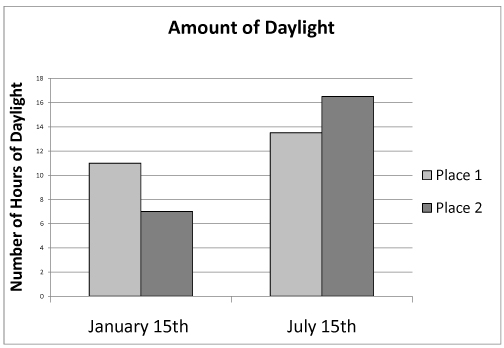Item CL043002: In the northern hemisphere, the farther north a place is from the equator, the lower is the maximum height that the sun reaches in the sky both in January and in July.
A student who lives at Place 1 measured the number of hours of sunlight on a day in January and on a day in July. Another student, who lives at Place 2 made the same measurement on the same two days. Both places are in the northern hemisphere.

Based on their measurements, as shown in the graph above, what must be TRUE about Place 2?
- Place 2 is closer to the Equator than Place 1.
- Place 2 is farther from the Equator than Place 1.
- Place 2 is farther to the east than Place 1.
- Place 2 could be north, south, or east of Place 1, because the number of hours of sunlight cannot be used to compare the location of one place to another.
Answer Choice |
Overall |
Grades |
Gender |
Primary Language |
||||
|---|---|---|---|---|---|---|---|---|
| n = 2220 |
6–8 n = 1239 |
9–12 n = 970 |
Male n = 1076 |
Female n = 1081 |
English n = 1905 |
Other n = 238 |
||
| A. | Place 2 is closer to the Equator than Place 1. | 30% | 30% | 31% | 29% | 32% | 31% | 23% |
| B. | Place 2 is farther from the Equator than Place 1. | 28% | 26% | 29% | 30% | 26% | 28% | 31% |
| C. | Place 2 is farther to the east than Place 1. | 19% | 20% | 18% | 19% | 19% | 19% | 23% |
| D. | Place 2 could be north, south, or east of Place 1, because the number of hours of sunlight cannot be used to compare the location of one place to another. | 23% | 24% | 21% | 23% | 23% | 22% | 24% |

